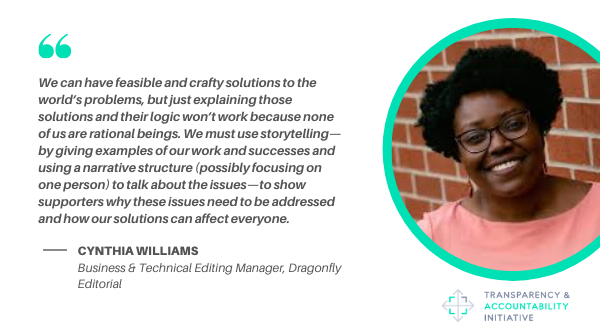
As a freelancer and in-house editor with Dragonfly Editorial, Cynthia Williams has enjoyed working with many organizations in the transparency, accountability, and civic space arena. In addition to Transparency and Accountability Initiative, she has worked with Common Cause, Open Government Partnership, Public Citizen, Thousand Currents, and others to advance work in the public interest.
Recently, she worked on reports that assess open data initiatives in Afghanistan and Nigeria, examine environmental outcomes in marginalized US communities, and call for government accountability in the creation of US dietary guidelines.
How would you describe the impact of storytelling in communicating work done by nonprofits and philanthropy organizations?
While every nonprofit I have worked with has done great public advocacy work, getting the public and potential funders excited about that work primarily involves appeals to the heart, as opposed to appeals to logic. We can have feasible and crafty solutions to the world’s problems, but just explaining those solutions and their logic won’t work because none of us are rational beings. We must use storytelling—by giving examples of our work and successes and using a narrative structure (possibly focusing on one person) to talk about the issues—to show supporters why these issues need to be addressed and how our solutions can affect everyone.
 In your experience of writing policy papers, program evaluations, and research reports, what’s your biggest challenge? How have you been able to mitigate these challenges?
In your experience of writing policy papers, program evaluations, and research reports, what’s your biggest challenge? How have you been able to mitigate these challenges?
As an editor and writer, I know that sometimes we forget who our audience is. In our papers, we want to say to our peers, “Hey, I know my stuff!” But if I am working on an analysis that reporters and the general public need to understand, sometimes I have to scale back the jargon and remember to have a more relaxed tone, as if I were explaining my idea to my niece who just graduated college. I don’t write much, but I see that as a challenge in my writing and editing.
What are your essential dos and don’ts of writing and editing?
On writing, I’d note again to scale back jargon when possible. For example, if a term isn’t in Merriam-Webster’s, it’s a good idea to explain it if it will be repeated. If it won’t be repeated, I suggest deleting it. Also, too many prepositional phrases can give writing a monotonous tone (e.g., “Think about the benefits of the program of Lead with Education” instead of “Think about the benefits of Lead with Education’s program”). So it’s best to avoid them.
That said, with editing, it is important to be mindful of terms of art in the writer’s field. Before an editor makes a global change to a document to delete a term or phrase she doesn’t recognize, she should Google the term within the context of the paper or query the author. Also, help the author ensure consistency through the document. If the overall population is listed as 5.8 million on page 2, it should be so on page 15.
What communication blunder makes you cringe, and what communication trends excite you the most at the moment?
I’m really excited about the move to infographics and professionally designed tables, etc., to relay information that can be captured succinctly. This helps to keep readers’ eyes moving, and their minds interested over a long read and also helps readability (especially in our social media era of short attention spans).
There aren’t any communication blunders that make me cringe, as we are all trying to get to better drafts and incorporate the knowledge we come across. But I would keep that in mind: our drafts can always get better, especially with feedback from our teams.
If you would offer advice or give recommendations for communications in this field (nonprofit and philanthropic sector), what would it be and why?
Writing for readability and making use of white space are essential tools in the era of online reading. That involves using shorter paragraphs, shorter sentences, fewer acronyms, bulleted lists, and graphics (when possible). These elements can be used in a Word document or a professionally designed report.
